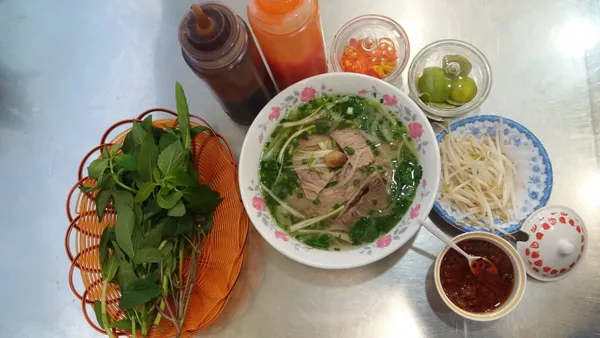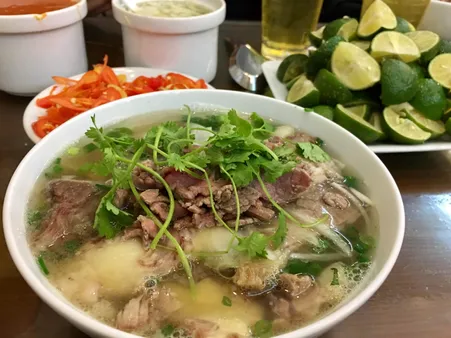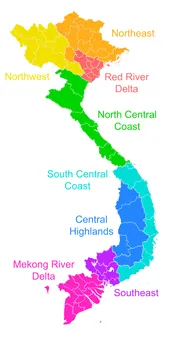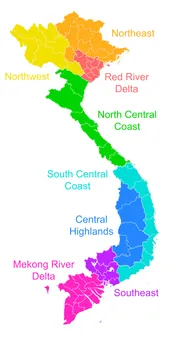Table of Contents
The cuisine of Vietnam is a reflection of its diverse geography and rich history, with each region boasting its own unique flavors and dishes. The difference between northern and southern Vietnamese cuisine is particularly striking, reflecting the country's history, geography, and culture. Northern Vietnamese cuisine is known for its lighter flavors, with a focus on fresh ingredients and herbs. Southern Vietnamese cuisine, on the other hand, is known for its bolder flavors, with a greater use of spices and sauces. In this article, we will explore the key differences between northern and southern Vietnamese cuisine, examining the ingredients, cooking techniques, and cultural influences that have shaped each region's unique culinary heritage. Join us on Tauhuichiban as we delve into the diverse and delicious world of Vietnamese cuisine.

The Difference Between Northern and Southern Vietnamese Cuisine: A Culinary Journey
I. The Distinctive Flavors of Northern Vietnamese Cuisine
Northern Vietnamese cuisine is known for its lighter flavors, with a focus on fresh ingredients and herbs. Dishes such as pho, bun cha, and cha ca are all representative of this style of cooking. The use of fish sauce, shrimp paste, and soy sauce is common in northern Vietnamese cuisine, and these ingredients add a unique flavor to the dishes.
One of the most popular dishes in northern Vietnam is pho. Pho is a noodle soup made with beef or chicken broth, rice noodles, and a variety of toppings such as beef, chicken, or tofu. The broth is typically simmered for several hours, and the noodles are cooked in the broth until they are soft. Pho is often served with a side of fresh herbs, such as cilantro, basil, and mint, and a squeeze of lime juice.
Dish | Description |
|---|---|
Pho | A noodle soup made with beef or chicken broth, rice noodles, and a variety of toppings. |
Bun cha | A dish made with grilled pork patties, rice noodles, and a dipping sauce. |
Cha ca | A dish made with grilled fish, rice noodles, and a dipping sauce. |
Another popular dish in northern Vietnam is bun cha. Bun cha is a dish made with grilled pork patties, rice noodles, and a dipping sauce. The pork patties are typically marinated in a mixture of fish sauce, garlic, and sugar, and then grilled over charcoal. The rice noodles are cooked in a separate pot, and the dipping sauce is made with fish sauce, vinegar, sugar, and chili peppers.
Cha ca is another popular dish in northern Vietnam. Cha ca is a dish made with grilled fish, rice noodles, and a dipping sauce. The fish is typically marinated in a mixture of turmeric, garlic, and ginger, and then grilled over charcoal. The rice noodles are cooked in a separate pot, and the dipping sauce is made with fish sauce, vinegar, sugar, and chili peppers.
Northern Vietnamese cuisine is a delicious and flavorful cuisine that is sure to please everyone. If you are looking for a taste of authentic Vietnamese food, then be sure to try some of the dishes mentioned above.

The Distinctive Flavors of Northern Vietnamese Cuisine
II. The Bold and Vibrant Southern Vietnamese Cuisine
In contrast to the lighter flavors of northern Vietnamese cuisine, southern Vietnamese cuisine is known for its bolder flavors, with a greater use of spices and sauces. Dishes such as bun bo Hue, com tam, and ca kho to are all popular examples of southern Vietnamese cuisine.
One of the most popular dishes in southern Vietnam is bun bo Hue, a spicy beef noodle soup. The soup is made with a flavorful broth that is simmered for hours with beef bones, lemongrass, and other spices. The noodles are typically made from rice and are served with a variety of toppings, such as beef, pork, and vegetables.
Dish | Description |
|---|---|
Bun bo Hue | Spicy beef noodle soup |
Com tam | Broken rice with grilled pork |
Ca kho to | Braised fish in a clay pot |
Another popular dish in southern Vietnam is com tam, or broken rice. Com tam is made with rice that has been broken into small pieces and then cooked. The rice is typically served with grilled pork, vegetables, and a dipping sauce.
Ca kho to, or braised fish in a clay pot, is another popular dish in southern Vietnam. The fish is typically braised in a flavorful sauce made with soy sauce, fish sauce, and other spices. The fish is served with rice and vegetables.
Southern Vietnamese cuisine is a delicious and flavorful cuisine that is sure to please everyone. If you are looking for a taste of authentic Vietnamese food, be sure to try some of the dishes from southern Vietnam.
Here are some additional tips for enjoying southern Vietnamese cuisine:
- Be sure to try a variety of dishes to get a taste of the different flavors of southern Vietnamese cuisine.
- Don't be afraid to ask for recommendations from your server or other diners.
- Be sure to enjoy your meal with a cold beer or glass of wine.
If you are looking for a great place to try southern Vietnamese cuisine, be sure to check out one of the many Vietnamese restaurants in your area. You can also find many recipes for southern Vietnamese dishes online.

The Bold and Vibrant Southern Vietnamese Cuisine
III. Exploring the Origins of the Culinary Divide
The culinary divide between northern and southern Vietnamese cuisine is a testament to the country's rich history and diverse geography. Northern Vietnamese cuisine is known for its lighter flavors, with a focus on fresh ingredients and herbs. Dishes such as pho, bun cha, and cha ca are all representative of this style of cooking. Southern Vietnamese cuisine, on the other hand, is known for its bolder flavors, with a greater use of spices and sauces. Dishes such as bun bo Hue, com tam, and ca kho to are all popular examples of southern Vietnamese cuisine.
There are a number of factors that have contributed to the development of these distinct culinary traditions. One factor is the climate. Northern Vietnam has a cooler climate than southern Vietnam, which has led to the development of a cuisine that is more reliant on hearty, warming dishes. Southern Vietnam, on the other hand, has a warmer climate, which has allowed for the development of a cuisine that is more focused on fresh, light dishes.
Northern Vietnamese Cuisine | Southern Vietnamese Cuisine |
|---|---|
Lighter flavors | Bolder flavors |
Focus on fresh ingredients and herbs | Greater use of spices and sauces |
Dishes such as pho, bun cha, and cha ca | Dishes such as bun bo Hue, com tam, and ca kho to |
Another factor that has contributed to the culinary divide is the history of Vietnam. Northern Vietnam has been influenced by Chinese cuisine, while southern Vietnam has been influenced by Thai and Cambodian cuisine. These influences can be seen in the use of ingredients, cooking techniques, and flavors in the two cuisines.
Today, the culinary divide between northern and southern Vietnamese cuisine is still evident. However, there is also a growing trend towards fusion cuisine, which combines elements of both traditions. This trend is particularly popular in urban areas, where people are more likely to be exposed to a variety of culinary influences.
Whether you prefer the lighter flavors of northern Vietnamese cuisine or the bolder flavors of southern Vietnamese cuisine, there is no doubt that both traditions have something to offer. The culinary divide between the two regions is a testament to the rich diversity of Vietnamese culture.

Exploring the Origins of the Culinary Divide
IV. The Influence of Geography and History on Vietnamese Cuisine
The diverse landscape of Vietnam, from the mountainous north to the fertile Mekong Delta, has played a significant role in shaping its cuisine. The country's long history, marked by foreign influences and cultural exchanges, has further enriched its culinary traditions.
Northern Vietnamese cuisine is known for its lighter flavors, with a focus on fresh ingredients and herbs. Dishes such as pho, bun cha, and cha ca are all representative of this style of cooking. Southern Vietnamese cuisine, on the other hand, is known for its bolder flavors, with a greater use of spices and sauces. Dishes such as bun bo Hue, com tam, and ca kho to are all popular examples of southern Vietnamese cuisine.
Region | Characteristics | Popular Dishes |
|---|---|---|
Northern Vietnam | Lighter flavors, focus on fresh ingredients and herbs | Pho, bun cha, cha ca |
Southern Vietnam | Bolder flavors, greater use of spices and sauces | Bun bo Hue, com tam, ca kho to |
The influence of China, France, and Southeast Asia can be seen in many Vietnamese dishes. For example, the use of soy sauce and rice noodles in pho is a reflection of Chinese influence, while the use of baguettes in banh mi is a nod to French colonialism. The use of lemongrass, galangal, and kaffir lime leaves in many Vietnamese dishes is a reflection of Southeast Asian influence.
Vietnamese cuisine is a testament to the country's rich history and diverse geography. It is a cuisine that is constantly evolving, with new dishes and flavors being created all the time. However, the traditional dishes that have been passed down through generations continue to be the heart of Vietnamese cuisine.

The Influence of Geography and History on Vietnamese Cuisine
V. Conclusion
The differences between northern and southern Vietnamese cuisine are a reflection of the country's rich history, diverse geography, and cultural influences. While each region has its own unique flavors and dishes, they are all united by a common love of fresh ingredients and delicious food. Whether you prefer the lighter flavors of the north or the bolder flavors of the south, there is something to enjoy in every region of Vietnamese cuisine. So next time you're looking for a delicious and authentic Vietnamese meal, be sure to explore the different regional cuisines and find your favorite dishes.